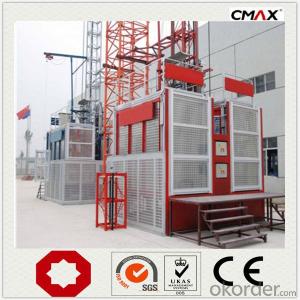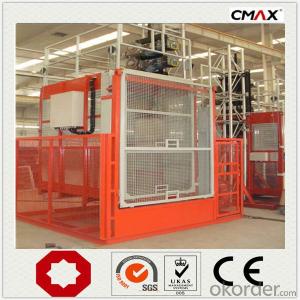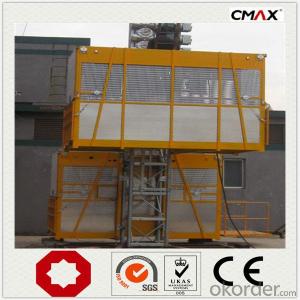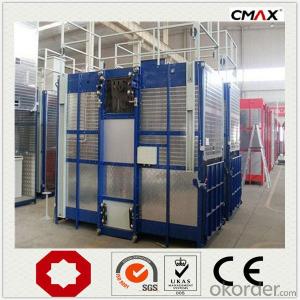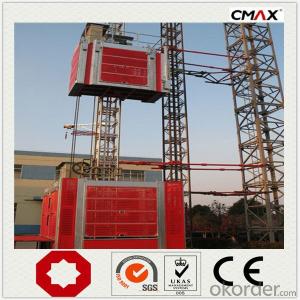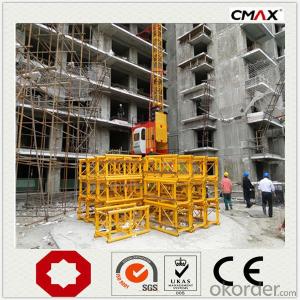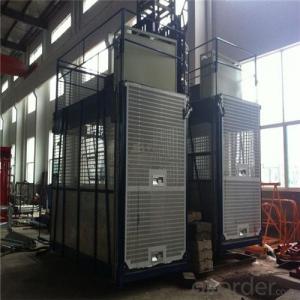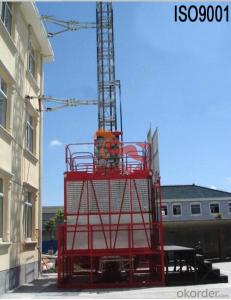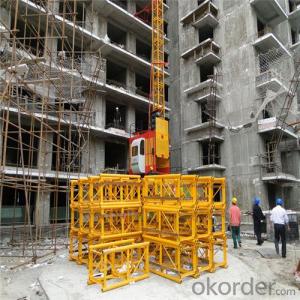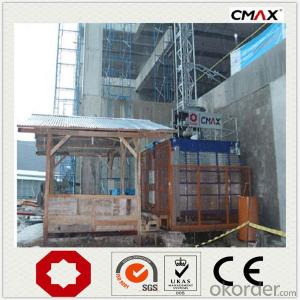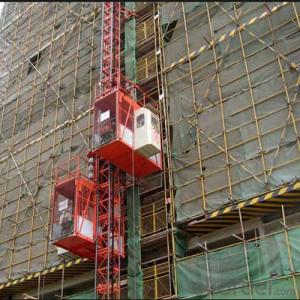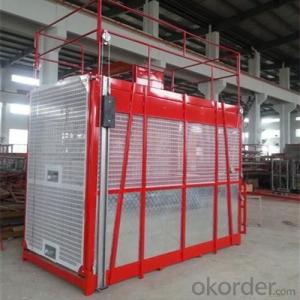Building Hoist 3200kg Single Cage Transportation
- Loading Port:
- China main port
- Payment Terms:
- TT OR LC
- Min Order Qty:
- 1 unit
- Supply Capability:
- 30 unit/month
OKorder Service Pledge
OKorder Financial Service
You Might Also Like
Specification
Building Hoist Description
Condition: New
Application: Construction
Payload(kg):3200
Lifting Speed(m/min):0~60
Motor Power(kw): 3*15
Safety Device: SAJ50-1.4
Cage: Single
Counterweight: Yes
Certification: CE,ISO
Place of Origin: China(Mainland)
Model Number: Type:SCD320
Packaging & Delivery of Building Hoist
Packaging Detail: Nude package
Delivery Detail: 25-30days
Features of Building Hoist
●Due to the strict raw material procurement control system, our drive motors for construction hoist/ building lift /material elevator for bridge/ tower / chimney / building is guaranteed with safe and reliable performance.
●The steel, electrical components, hoist cables, high strength bolts and spare parts are all introduced from well-known international and domestic suppliers.
●Adopts the most advanced VF speed control device and microcomputer programmable logic controller.
● Stepless speed control helps eliminate the concussion during start up and braking, steady the operation process,
and ensures automated leveling.
● Adopts open loop V/Fcontrol; the speed control precision can reach ±2~3%. Realizes accurate low speed positioning of the hoist and avoid slipping during downward stopping of hoist.
● The VF system has current-restriction function, ensuring a small current when motor start up and reducing the concussion to power supply. It reduces the engery consumption and mitigates effects to on site electric equipments.
Building Hoist Images

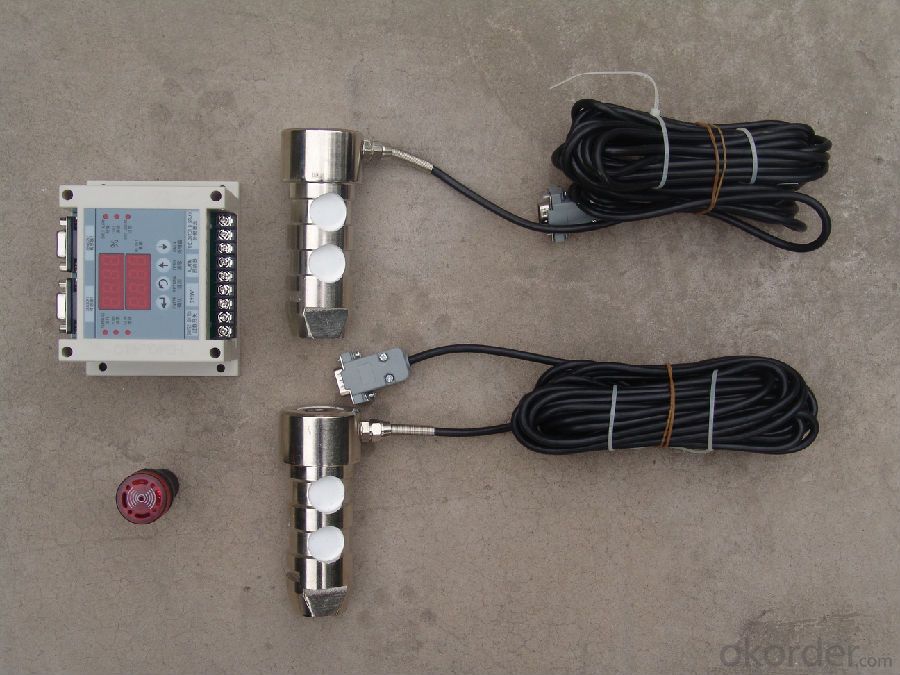
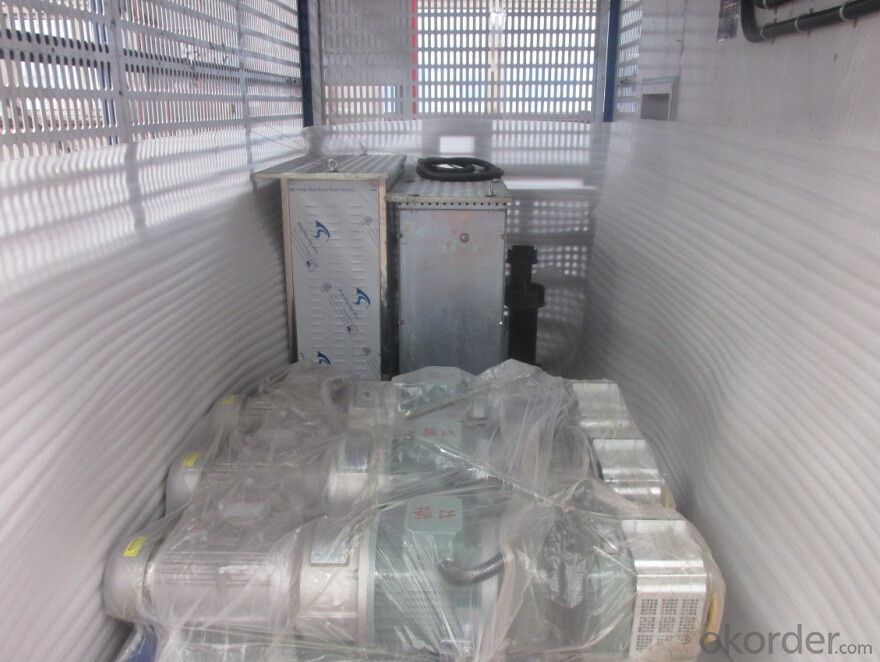
Building Hoist Specifiction
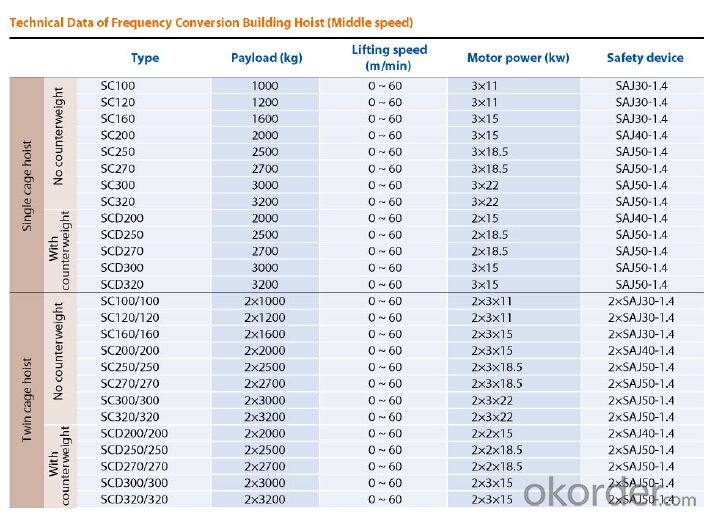
FAQ of Building Hoist
Q: What is the building hoist main purpose?
A: Building hoist equipped with double or single cabin to transport the materials and labors up and down. It's the ideal
construction equipment for vertical transportation in the field of construction.
Q: What is the main structure of building hoist?
A: The P/M construction hoist mainly contains metal structure, driving system, electrical control system, cable guide &
protection system, electrical top crane and safety device.
Q: What is the meaning of the building hoist’s code?
A: Take SC200/200 for example: “SC” stands for rack and pinion hoist, “200/200” stands for double cage and capacity
is 2 tons per cage. “SC200” stands for single cage and capacity is 2 tons.
- Q: Is it possible to use a single automatic building hoist to lift multiple objects simultaneously?
- <p>Yes, an automatic building hoist can be used to lift multiple objects at once, provided that the combined weight of the objects does not exceed the hoist's maximum load capacity. It is crucial to ensure that the hoist is designed for such operations and that all safety precautions are taken to prevent overloading, which can lead to accidents. The hoist should be equipped with a load limiter to automatically cut off power if the load exceeds safe limits, ensuring the safety of the operation.</p>
- Q: What precautions should be taken when using lifting equipment to ensure safety?
- <p>Safety measures for lifting equipment include regular inspections and maintenance to ensure equipment is in good working order. Operators must be trained and certified for the specific equipment they are using. Safe lifting practices should be followed, such as never exceeding load limits, using the correct lifting points, and securing loads properly. Personal protective equipment (PPE) should be worn, and clear communication among the lifting team is essential. Additionally, a safe working environment should be maintained, free from obstructions and hazards, and emergency procedures should be in place and known by all involved.</p>
- Q: What are the alternative uses of a building hoist besides construction?
- <p>Yes, building hoists can be used for other purposes beyond construction. They can be utilized in various industries for material handling, such as in warehouses for moving goods, in factories for lifting machinery, and in maintenance for accessing high areas. Additionally, building hoists can be employed in emergency services for rescue operations, especially in high-rise buildings. They are also used in special events for setting up stages and equipment. The versatility of building hoists makes them a valuable tool in many different scenarios where vertical transportation of materials or personnel is required.</p>
- Q: What are the specific safety mechanisms and controls that are typically incorporated into the design of a building hoist to ensure its safe operation?
- <p>Building hoists, also known as construction hoists, are equipped with several safety devices and controls to ensure safe operation. These include limit switches to prevent overtravel, safety locks that engage if the hoist sways excessively, emergency stop buttons for immediate cessation of movement, overload protection to prevent the hoist from lifting more than its capacity, and interlock systems that ensure the hoist cannot operate if a safety gate is open. Additionally, there are guardrails, toe boards, and anti-fall devices to protect workers from falling. Regular inspections and maintenance are also crucial for the safe operation of building hoists.</p>
- Q: Is the construction elevator a special equipment
- Belong to special equipment construction lifter, but generally used as home building municipal engineering does not belong to the quality and technical supervision management, but belong to the administration of urban construction. Because the system of quality control unless invited, shall not be involved in military, aerospace, nuclear industry, mine, municipal, sea, railway locomotive hoisting machinery management.
- Q: Is it possible to replace an electric control panel with a manual lever in a lifting system?
- <p>While it is theoretically possible to use a manual lever as a substitute for an electric control panel in a lifting system, it is not advisable. Manual levers lack the precision, safety features, and control capabilities of electric control panels. They also cannot provide the same level of feedback or automation. Electric control panels are designed to ensure safe and efficient operation, with features like emergency stop buttons, overload protection, and remote monitoring. Manual levers can pose safety risks and may not meet the operational requirements of modern lifting systems.</p>
- Q: Safety device for construction elevator
- When the cage is in an emergency for various reasons during the operation, the driver can press the stop switch at any time, making the cage stop running. The fast stop must be a non-self-restoring safety device, usually installed in the top of the cageConstruction lifter lifting door, protective enclosure door are equipped with electric interlock switch, which can effectively prevent because of hoisting cage or protective enclosure door open it up and running and materials caused by falling, only when the hoisting cage door and protective enclosure fully closed to start running.
- Q: Describe the process of utilizing a computer control system for operating a building hoist.
- <p>To use a computer control system for a building hoist, first ensure the system is properly installed and integrated with the hoist's mechanical and electrical components. Begin by powering on the control system and checking for any error messages that might indicate a problem. Once the system is ready, input the desired parameters such as load weight, lifting height, and speed settings. Use the control panel to initiate the hoist's movement, monitoring the progress on the system's display. Adjust the hoist's operation in real-time as needed, ensuring safety protocols are followed. Regularly check system diagnostics for maintenance alerts and address any issues promptly to maintain optimal performance.</p>
- Q: What precautions should be taken when using manual lifting equipment to ensure safety?
- <p>Safety measures for using manual lifting devices include inspecting equipment for damage before use, ensuring the load is within the device's weight capacity, using proper lifting techniques, maintaining a clear path for lifting, and securing the load to prevent shifting. Always wear appropriate personal protective equipment, such as gloves and safety shoes. Never exceed the rated capacity of the lifting device, and avoid sudden or jerky movements that could cause loss of control. Regular maintenance and training on safe lifting practices are also crucial to prevent accidents.</p>
- Q: Is it possible to use two lifting devices simultaneously to lift an object that is heavier than the maximum weight each device can handle individually?
- <p>Yes, two lifting devices can be used together to lift a heavier object than either one can handle alone, provided that both devices are capable of supporting the combined weight and are properly synchronized. This requires careful planning and coordination to ensure the safety of the operation and the integrity of the lifting devices. The total weight capacity of the combined system should be greater than the weight of the object being lifted, and the devices must be designed to work in tandem without overloading or causing damage.</p>
Send your message to us
Building Hoist 3200kg Single Cage Transportation
- Loading Port:
- China main port
- Payment Terms:
- TT OR LC
- Min Order Qty:
- 1 unit
- Supply Capability:
- 30 unit/month
OKorder Service Pledge
OKorder Financial Service
Similar products
Hot products
Hot Searches
Related keywords
